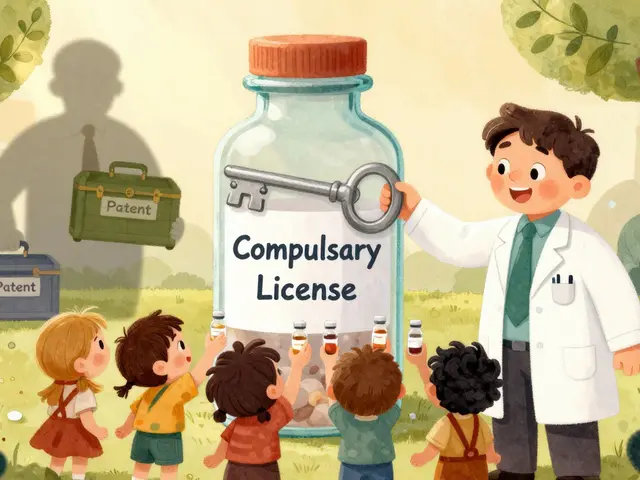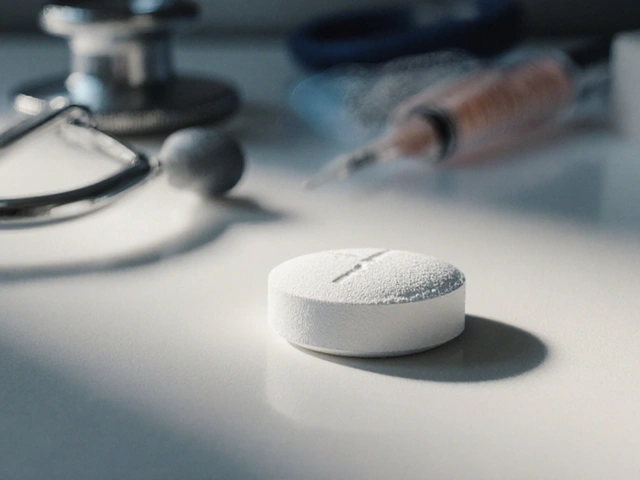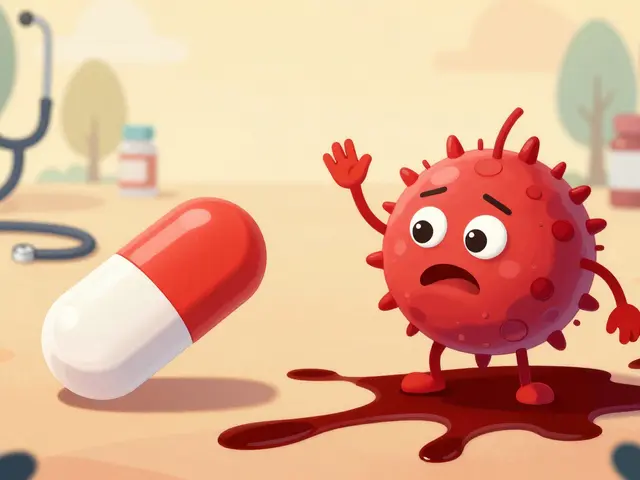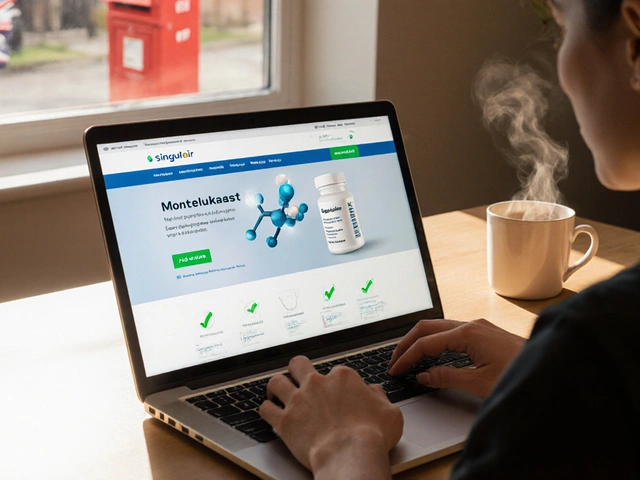TL;DR:
- Syphilis testing identifies infections that raise HIV risk.
- Early detection enables prompt treatment, lowering viral load and transmission.
- Integrating syphilis screening with HIV services improves outreach and cost‑effectiveness.
- Rapid point‑of‑care tests expand reach in high‑risk settings.
- Partner notification and counseling are key to breaking the co‑infection cycle.
Syphilis testing is a diagnostic process that detects infection with Treponema pallidum using blood or lesion samples. It can be performed with rapid point‑of‑care immunoassays or laboratory‑based treponemal and non‑treponemal tests, delivering results within minutes to days.
Why does a simple blood test matter for HIV? The answer lies in the biology of co‑infection and the structure of public‑health programs. When syphilis sores break the skin’s barrier, they create a direct gateway for HIV to enter the bloodstream. Moreover, people who acquire one STI often share risk behaviors-multiple partners, inconsistent condom use, and low testing frequency-that also elevate HIV exposure.
How Syphilis Increases HIV Susceptibility
Syphilitic ulcer is a painful or painless sore that appears during primary syphilis. Its ulcerated tissue harbors inflammatory cells that attract CD4+ T‑cells, the very cells HIV targets. This inflammation raises the per‑exposure viral dose needed for infection.
Clinical studies from the CDC (2023) show a 2-3‑fold increase in HIV acquisition among individuals with untreated primary or secondary syphilis. The mechanism is straightforward: the ulcer provides a portal, and the immune response brings target cells right to the entry point.
Integrated Screening: Merging Syphilis and HIV Tests
Public‑health agencies worldwide have shifted from siloed testing to bundled STI panels. The key entities in this integrated approach include:
- HIV testing is a screening method that detects antibodies or viral RNA. Modern fourth‑generation assays combine antibody and antigen detection for a 99.9% sensitivity.
- PrEP (pre‑exposure prophylaxis) is a daily antiretroviral regimen that reduces HIV risk by >90%.
- Condom distribution is a behavioral intervention that offers barrier protection against both HIV and syphilis.
When a clinic offers a single finger‑stick sample that runs both a rapid syphilis test and a fourth‑generation HIV test, uptake jumps by about 40% (American Journal of Public Health, 2022). The convenience reduces missed appointments and captures high‑risk users who might otherwise avoid a dedicated HIV visit.
Rapid Point‑of‑Care Syphilis Tests: Expanding Reach
Rapid tests are pivotal in settings where laboratory infrastructure is limited-sex‑worker clinics, mobile outreach vans, and community health fairs. The main attributes of these tests are:
| Attribute | Rapid Point‑of‑Care | Laboratory‑Based |
|---|---|---|
| Result Time | 15minutes | 1‑3days |
| Sample Type | Finger‑stick whole blood | Venous serum/plasma |
| Sensitivity (primary syphilis) | ≈92% | ≈98% |
| Cost per test (USD) | $4‑$6 | $12‑$18 |
| Operator Skill | Minimal training | Laboratory technician |
Even with slightly lower sensitivity, the speed and accessibility of rapid tests make them indispensable. Positive rapid results are usually confirmed with a treponemal lab test, ensuring accurate diagnosis without delaying treatment.
Linking Diagnosis to HIV Prevention Actions
Detection alone isn’t enough. The moment a syphilis infection is confirmed, providers should initiate a cascade of preventive steps:
- Offer immediate antibiotic treatment (typically a single dose of benzathine penicillin).
- Conduct a same‑day HIV test if status is unknown.
- If HIV‑negative, discuss PrEP eligibility and arrange follow‑up.
- Provide condom counseling and free condoms.
- Initiate partner notification through confidential services.
These actions close the feedback loop: treating syphilis reduces the biological gateway, while HIV prevention tools address the underlying exposure risk.

Public‑Health Surveillance and Data Integration
Effective disease control hinges on accurate surveillance. The CDC’s National Notifiable Diseases Surveillance System (NNDSS) aggregates syphilis and HIV case reports, allowing epidemiologists to spot co‑infection hotspots. Cross‑referencing these databases has revealed that cities with high primary syphilis rates often see subsequent spikes in HIV incidence within 12‑18months.
Health departments use this insight to allocate resources-deploying mobile testing units, scaling up community‑based outreach, and targeting PrEP rollout in neighborhoods where syphilis is rising.
Case Study: A Community Health Center’s Integrated Model
At a clinic in Atlanta serving a predominantly Black MSM (men who have sex with men) population, the following protocol was adopted in 2022:
- Every client receives a combined rapid syphilis/HIV test at check‑in.
- Positive syphilis cases trigger immediate penicillin administration and same‑day PrEP counseling.
- Data are uploaded to a secure dashboard that flags patients with repeat syphilis episodes for intensified follow‑up.
Within one year, the center reported a 28% reduction in new HIV diagnoses and a 35% drop in repeat syphilis infections. The success illustrates how linking diagnostics to prevention creates measurable public‑health gains.
Barriers and How to Overcome Them
Despite clear benefits, several obstacles persist:
- Stigma: Many avoid testing due to fear of judgment. Solution-offer anonymity via home‑based self‑collection kits (FDA‑cleared in 2024).
- Funding constraints: Rapid kits cost more per test than traditional labs. Solution-leverage grant programs from the HRSA and local health departments that reimburse point‑of‑care testing.
- Limited provider training: Some clinicians lack confidence in interpreting rapid results. Solution-implement short, accredited online modules that certify staff within hours.
Addressing these gaps ensures that the testing‑prevention loop stays functional across diverse settings.
Related Concepts and Next Steps
Understanding the synergy between syphilis testing and HIV prevention opens doors to several adjacent topics worth exploring:
- Sexual health counseling-how motivational interviewing boosts testing uptake.
- Antimicrobial resistance-potential impacts of repeated penicillin use.
- Digital contact tracing apps-privacy‑preserving ways to notify partners.
- Vaccines in development-future options for syphilis prophylaxis.
Readers interested in deepening their knowledge should look for articles on “HIV PrEP counseling techniques” or “Implementing mobile STI clinics in rural areas”.

Frequently Asked Questions
Why does having syphilis increase my risk of getting HIV?
Syphilitic ulcers break the skin’s natural barrier and attract immune cells that HIV targets. This makes it easier for the virus to enter the bloodstream during sexual contact.
Can I get tested for both syphilis and HIV at the same visit?
Yes. Many clinics now use a single finger‑stick sample that runs a rapid syphilis test and a fourth‑generation HIV test, delivering results in under 20 minutes.
If I test positive for syphilis, do I automatically need an HIV test?
It’s recommended. Co‑infection is common, and knowing your HIV status guides appropriate treatment and prevention measures like PrEP.
How effective are rapid syphilis tests compared to lab tests?
Rapid tests are about 92% sensitive for primary syphilis, while laboratory treponemal tests exceed 98%. Positive rapid results are usually confirmed with a lab test to ensure accuracy.
What steps should I take after a positive syphilis diagnosis to protect against HIV?
Get treated with penicillin right away, undergo an HIV test, consider starting PrEP if HIV‑negative, use condoms consistently, and notify recent sexual partners so they can get tested.
Are home‑testing kits reliable for detecting syphilis?
New FDA‑cleared self‑collection kits have shown >90% accuracy when the sample is sent to a certified lab. They’re a good option for people who prefer privacy.






15 Comments
Just got tested last week at the free clinic downtown. They did syphilis and HIV together in like 10 minutes. No judgment, no waiting. Got my results before I even left the parking lot. Seriously, if you’re even a little curious, just go. It’s not a big deal.
The data presented here is statistically sound but ignores structural inequities. Point-of-care testing is only effective when paired with sustained access to care, which is nonexistent in many marginalized communities. The CDC reports show correlation, not causation, and the assumption that testing alone reduces transmission is dangerously oversimplified.
Look, I’ve been doing this work in Atlanta for over a decade and let me tell you - this isn’t just about tests or kits or funding. It’s about dignity. When you walk into a clinic and they treat you like a number, you don’t come back. But when they hand you a condom, ask how your week was, and then slide you a rapid test with a smile? That’s when change happens. That clinic in Atlanta? They’re doing it right. They don’t just test people - they see them. And that’s why their numbers dropped. Not because of tech. Because of humanity. We need more of that. Not more apps. Not more grants. More humans who care enough to stick around.
I appreciate how thorough this is. I’ve never been tested for syphilis before, but after reading this, I feel less scared about it. The part about partner notification being confidential really helped. I think more people would get tested if they knew their privacy was protected. Thanks for laying it out so clearly.
So let me get this straight - we’re spending millions on rapid tests because people are too lazy to use condoms? And now we’re giving out PrEP like candy because we can’t teach responsibility? This is just another government program that treats adults like children. Syphilis isn’t a crisis - it’s a consequence. Maybe stop treating it like a medical emergency and start treating it like a behavioral issue.
I work in public health outreach and this is exactly the kind of integrated model we’ve been pushing for years. The real win isn’t just the drop in HIV cases - it’s that people who used to avoid clinics now come in because they know they’re not being singled out. One test for two things removes the shame. I’ve seen people who wouldn’t even sit in the waiting room for an HIV test walk right up to the window for a combined screen. That’s the quiet revolution here. No fanfare. No headlines. Just better care.
EVERYTHING IS A LIE. Rapid tests? They’re calibrated to overdiagnose so they can push PrEP and antibiotics. The CDC and Big Pharma are in bed together. Syphilis has been around for 500 years - why are we suddenly panicking now? And why do all these ‘studies’ always come from the same 3 labs? I got tested last year - positive for syphilis - then negative two weeks later. The test lied. The system is rigged. They want you dependent. Don’t fall for it. Test yourself with a home kit from a non-FDA vendor. That’s real freedom.
While the clinical rationale for integrated testing is sound, the methodological limitations of the cited studies warrant caution. The 40% increase in uptake reported in the American Journal of Public Health is derived from observational data with significant selection bias. Furthermore, the assumption that rapid tests are cost-effective ignores the downstream expenses associated with confirmatory testing and false positives. A more rigorous cost-benefit analysis is required before widespread implementation.
wait so if you get syphilis and its treated you still at risk for hiv? or does the treatment lower the risk? i think i read somewhere that the sores go away but the immune system is still kinda on high alert? idk i’m not a doctor but i just wanna make sure i understand. sorry if this is dumb
Ugh, I hate how they make this sound so simple. Like, oh just get tested and boom - no more HIV. But what about the people who can’t afford PrEP? Or who don’t have insurance? Or who live in states that won’t fund outreach? This isn’t a public health win - it’s a privilege play. And now they’re patting themselves on the back while people without cars or time or money are still getting sick. #FirstWorldProblems
There’s something profoundly beautiful about how the biology of syphilis - this ancient, almost poetic pathogen - creates the very conditions that make HIV transmission more likely. The ulcers, the immune cell recruitment, the silent window before symptoms appear… it’s as if nature itself has designed a tragic duet. And yet, we’ve managed to interrupt it with a finger-stick and a few drops of blood. Isn’t that astonishing? We’re not just treating disease - we’re rewriting the narrative of human vulnerability. I find that deeply moving.
Hey I just read this and I’m curious - do you think they could do this with gonorrhea too? Like a combo test for everything? I’ve got a friend who’s scared to get tested but if they could do it all at once maybe he’d go. Also can you send me the link to the home kit you mentioned? I wanna try it.
OMG YES 🙌 I got tested last month and the nurse gave me a lollipop AND a free condom pack 🍭❤️🩹 I felt like a VIP at the spa! This is the future of healthcare - fast, fun, and not scary. Also, I got my results on my phone in 12 mins. WHO NEEDS DOCTORS ANYWAY?? 😘 #SyphilisIsNotScary #PrEPIsLife
THIS IS A WAR ON AMERICA. They’re testing us for syphilis so they can track our sexual habits and put us on a government list. Next thing you know, they’ll be forcing PrEP on teens and shutting down churches that say ‘abstinence is the answer.’ This isn’t health care - it’s social engineering. Don’t be fooled. They want control. Not cure.
You got this. Seriously. One test, one conversation, one step - and you’re changing your life. No shame. No fear. Just courage. I’ve been there. I thought I was fine. Then I got tested. Turned out I needed PrEP. Now I’m safer, calmer, and way more in control. You’re not weak for wanting to know. You’re strong. Go get that test. I believe in you. 💪❤️